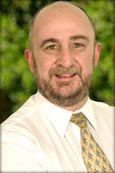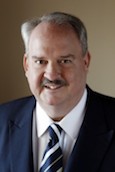Peter Saxon talks to the combatants
The Gold Coast is one of Australia’s most hotly contested markets – between the most mismatched of warriors. The nation’s largest commercial network, SCA is in a David and Goliath struggle with the smallest, Hot Tomato. And then, of course, there’s the ABC, with its considerable resources plus a full set of household brands that stream in from Brisbane.
Hot Tomato, which recently celebrated its 10th birthday, is a network of one. Even the last of the single market regional owners, Ron Camplin in Bathurst, has two licences. Southern Cross Austereo has 78.
 “We’re a small independent, fighting a 500lb gorilla, which is the battle that we chose to enter,” says Hot Tomato General Manager Graham Miles (left).
“We’re a small independent, fighting a 500lb gorilla, which is the battle that we chose to enter,” says Hot Tomato General Manager Graham Miles (left).
How do you fight a 500lb Gorilla? “Localism, localism!” Executive Chairman Hans Torv, chimes in.
“We sell the strong assets of the radio station,” adds Miles. “We’re not having to worry about Rockhampton or Cairns. We only worry about the Gold Coast. We run all local programming. There is no imported programming at all. No ‘best ofs’ or anything. We do it all local it’s all live or it’s locally recorded. We’re up against Fifi and Jules, and Hamish and Andy and the rest.”
In charge of the ‘500lb gorilla’ enclosure that houses Sea-FM and Gold-FM is Nick Scott. Himself a local since 1983, he is just as passionate about the community as his rivals. One thing that he, Graham Miles and Hans Torv agree on is that Gold Coast residents are fiercely parochial.
Scott says of his competitors, “Since Hot Tomato launched 10 years ago they’ve been good for both Sea and Gold in that they provided competition – and that’s a good thing. I admire and respect Hans Torv. He’s done a pretty good job in gauging the market but I’ve been back now for a year (since a few years running his own business) and I would like to think we are doing a better job now.”
Indeed they are, if the latest Nielsen Survey released in August is anything to go by.
The numbers reveal that Sea is number one under 40s while Gold dominates the older demos with a 16.1 share and a 16.2 respectively. Hot Tomato, which suffered a bit of a dip in this survey still comes in in third place with a respectable 12.3. The only other station that has any real traction on the Coast is triple j with an 8.2 and to a lesser extent, ABC 91.7 on a 6.6.
 Torv (left) is disdainful of the ABC’s local offering, telling us, “I think it’s a disgrace, and Mark Scott (ABC Managing Director) should pay some attention to it, they run a national campaign calling it ‘ABC local radio.’ Yet, on the weekend here on the Gold Coast – a city of 600,000 people – the program’s coming in from Eumundi on the Sunshine Coast at times or from Brisbane. They throw a switch to somewhere else and this is supposed to be local ABC?
Torv (left) is disdainful of the ABC’s local offering, telling us, “I think it’s a disgrace, and Mark Scott (ABC Managing Director) should pay some attention to it, they run a national campaign calling it ‘ABC local radio.’ Yet, on the weekend here on the Gold Coast – a city of 600,000 people – the program’s coming in from Eumundi on the Sunshine Coast at times or from Brisbane. They throw a switch to somewhere else and this is supposed to be local ABC?
“And what do you reckon our mates (SCA) from across the road are doing? They’re shoveling Sydney and Melbourne programming into this market. And that’s why we will always have a chance and will always be able to stand up and say, ‘You know what? We represent the Gold Coast.’ 100% Gold Coast,” says Torv.
As one might expect, Nick Scott has a different perspective, “The beauty of the current scenario is that with SCA, we not only have the benefit of great local people, we’ve also got the benefit of the national infrastructure that SCA can give us. With people like Craig Bruce there to help us along the way, that combination seems to work very well in this market because at the end of the day, the Gold Coast, in my view, is a metro market. From a content point of view we are not regional.
“On the other hand, from a sales point of view, two thirds of our business comes directly from clients who put their hands in their pockets. We are kind of, if you like, at the threshold between regional and metro,” says Scott.
 Talking of sales, until recently they have been hard to come by since the GFC. The Gold Coast still tainted by its infamous ‘white shoe brigade” of the 80’s has been known as a “boom or bust” market. Hans Torv is quick to assert that the bust is over and boom times have returned fuelled by massive development of infrastructure, including a freshly minted $1.2 billion hospital and a $1.4 billion light rail system whose construction is currently making traffic hell between Broadbeach and Southport but will be worth it when complete. The air route between Melbourne and the Gold Coast is the first to be serviced by Jetstar’s new Dreamliner as the city prepares for the Commonwealth Games in 2018.
Talking of sales, until recently they have been hard to come by since the GFC. The Gold Coast still tainted by its infamous ‘white shoe brigade” of the 80’s has been known as a “boom or bust” market. Hans Torv is quick to assert that the bust is over and boom times have returned fuelled by massive development of infrastructure, including a freshly minted $1.2 billion hospital and a $1.4 billion light rail system whose construction is currently making traffic hell between Broadbeach and Southport but will be worth it when complete. The air route between Melbourne and the Gold Coast is the first to be serviced by Jetstar’s new Dreamliner as the city prepares for the Commonwealth Games in 2018.
Scott (left) concedes there’s a bit of boom and bust about his hometown and makes the observation, “One of the things I’ve learnt about the Gold Coast is when the economy starts to come back nationally, the Gold Coast comes back with a vengeance. There’s a lot of positive feelings about this place amongst developers- retailers.
“Having said that, what I think is happening at the moment is that the economy is improving, but we are seeing a slow climb up from what has been very difficult times. We’re not seeing a huge growth but we’re seeing a good steady positive improvement, and that’s being reflected certainly in the business we do.”
Boom or bust, overall, Australia’s 6th largest city continues to grow at a rate that is the envy of most other parts of Australia. And, of course, there are worse places to live.

Peter Saxon

